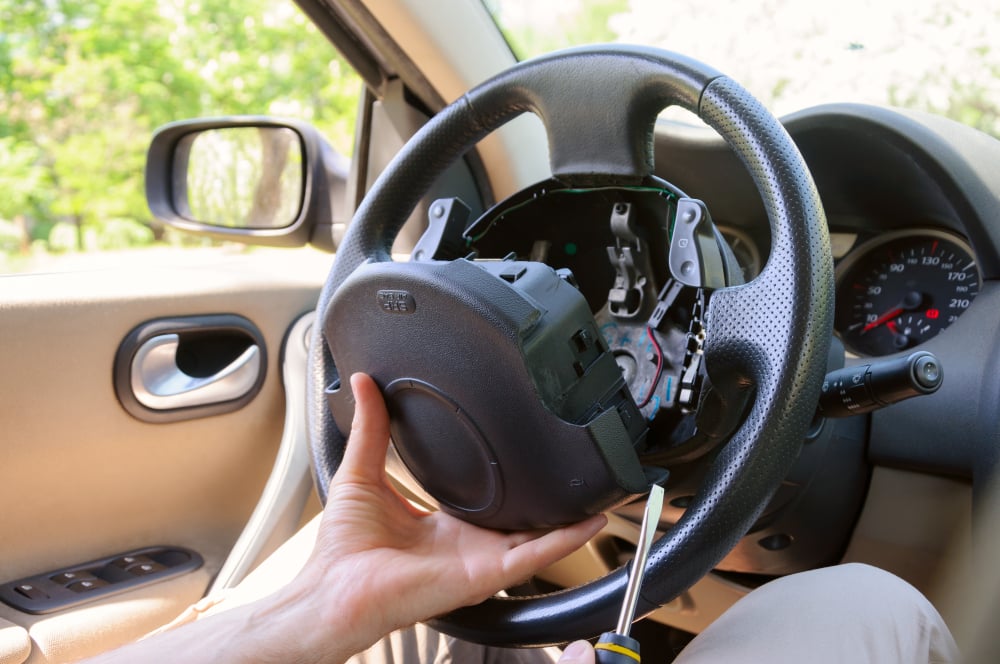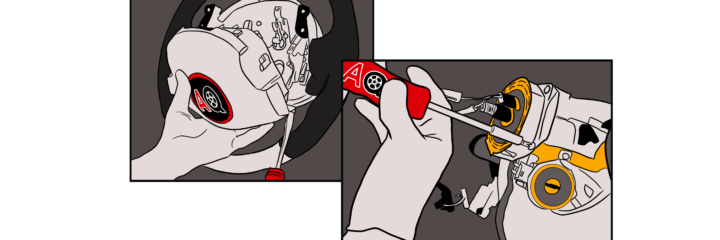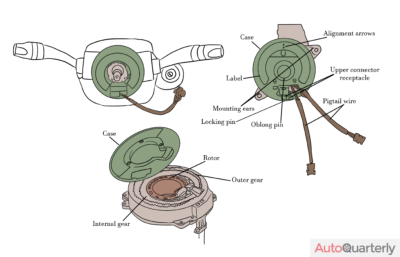Sometimes, it can feel like your car is more trouble than it’s worth. But modern life can make owning a car a basic necessity for people all across the world—especially for us in the US. And that means we have to take care of our cars.
The trouble is that most people aren’t mechanics and many of us have no freaking clue what we’re looking at when we pop the hood or pull off some housing and find the mess that lies beneath. Diagnosing random sounds, lights, and vibrations from scratch is a massive headache. But if you’ve found your way here, then you have an idea that the issue you’re having might be related to your clock spring.
Feel free to skip ahead to bad clock spring symptoms and clock spring replacement costs if you don’t want the lowdown on what clock springs are and how they work. First, let’s go over the basics.
What the Heck Is a Clock Spring?
Despite its name, a clock spring is neither a clock nor a spring. The clock spring got its name from what its internal mechanism looks like: a coiled ribbon wrapped around a shaft. Clock springs can go by a bunch of different names such as cable reel, contact reel, spiral cable, airbag clock spring, and steering wheel clock spring.
As you might be guessing by those last two names, the clock spring is located inside the steering wheel of virtually every car on the road these days. Its purpose is to maintain an electrical connection between the steering wheel and all its electronic components such as any media controls, cruise control, and horn buttons found on your steering wheel. It also maintains a connection to the driver’s airbag controls—making it a very important safety mechanism.
Maintaining an electrical connection doesn’t seem like it would require any special systems at first glance. But when you consider the fact that your steering wheel can rotate freely and make multiple rotations, you start to realize that keeping wires connected through all of that spinning might be difficult.
And that’s exactly what the clock spring does with its coil of ribbon. It allows the steering wheel to move freely while still maintaining an electrical connection with all the other systems built into your wheel.
If your car doesn’t have a horn, airbag, or steering wheel buttons, there’s a good chance it doesn’t have a clock spring at all, and your diagnostic process must continue elsewhere. For everyone else, read on to find out what signs indicate a bad clock spring is causing you issues.
Faulty Clock Spring Symptoms
Generally, bad clock springs are fairly easy to diagnose. One of the most obvious signs that there’s something wrong with your clock spring is the airbag warning light coming on.
Other issues you’ll likely notice if your clock spring has sprung are your steering wheel buttons or car horn not working at all, or not working when the steering wheel is turned in various positions. You may notice flickering or sporadic warning lights and your horn or steering wheel media controls working only intermittently if your clock spring is having issues.
Another sign of a bad clock spring is a grinding or scraping noise coming from inside the steering wheel whenever you turn it. Or the steering wheel might be harder to turn than usual as a result of the ribbon within the clock spring getting stuck.
Try turning your wheel through its full rotation in both directions with the car on to see if any of the signs mentioned above crop up. If you notice any combination of these problems, it’s very likely that the clock spring is the culprit behind your car troubles.
But don’t worry—a bad clock spring is fairly inexpensive to fix and can be replaced quickly by a mechanic or in a couple of hours at home with a few tools and a fair amount of elbow grease.
Clock Spring Repair and Replacement Costs
The clock spring itself isn’t a terribly expensive part—typically costing between $30 and $200. The replacement of a clock spring isn’t overly complex, but it can take up to a couple of hours to complete for people who don’t have a lot of experience. A mechanic shop should be able to get the job done in under an hour, two max—putting your labor cost anywhere from $70 all the way up to $250 depending on where you get the work done.
That puts the total cost of clock spring replacement in the $100-$450 range. Expect to pay more at dealerships than independent mechanic shops. You might be tempted to just carry on with a broken clock spring, but doing so would put you at greater risk of injury or death as the clock spring is responsible for keeping both your car horn and your airbag in working condition.
Replacing the clock spring at home is doable, but it’s definitely not a task for the faint of heart. The most important thing to know if you do want to try replacing your clock spring at home is that you must disconnect the battery before you get started because of the airbag. The entire steering wheel and airbag housing must be disassembled to get to the clock spring, and this poses the risk of your airbag detonating, which can cause serious injury or even death.
If you’re confident in your abilities and have some basic tools on hand, then this excellent video will show you the entire process of replacing a clock spring.

Clock Spring FAQ
Let’s close out this article with some quick-fire clock spring questions and answers.
Can I Drive With a Broken Clock Spring?
Technically, you can operate your vehicle without a clock spring; however, you will be placing yourself in danger by doing so, as a broken clock spring can prevent your airbag from deploying properly in the event of a crash. A broken clock spring can also prevent your horn from working—another potential safety issue that will prevent you from alerting other drivers quickly.
How Often Do Clock Springs Need to Be Replaced?
Clock springs are designed to last throughout the life of the vehicle, or roughly 80,000 miles on average, and don’t require any regular maintenance or replacement like other parts in your car.
How Much Does It Cost to Fix a Broken Clock Spring?
Repairing a bad clock spring involves the complete replacement of the unit which typically costs between $200-$400 for parts and labor combined.
What Causes a Clock Spring to Break?
Clock springs are designed to last for the life of the vehicle, but they can wear out over time. A free-spinning steering wheel can cause the ribbon in the clock spring to break free of the housing, and repair work done on the steering wheel or column might result in a damaged clock spring if proper care isn’t taken.
Clocking Off
Hopefully, by now you have successfully diagnosed your car troubles as a faulty clock spring. If nothing else, maybe you at least confirmed that your problem is NOT the clock spring and you can more quickly identify the issue with your car.




